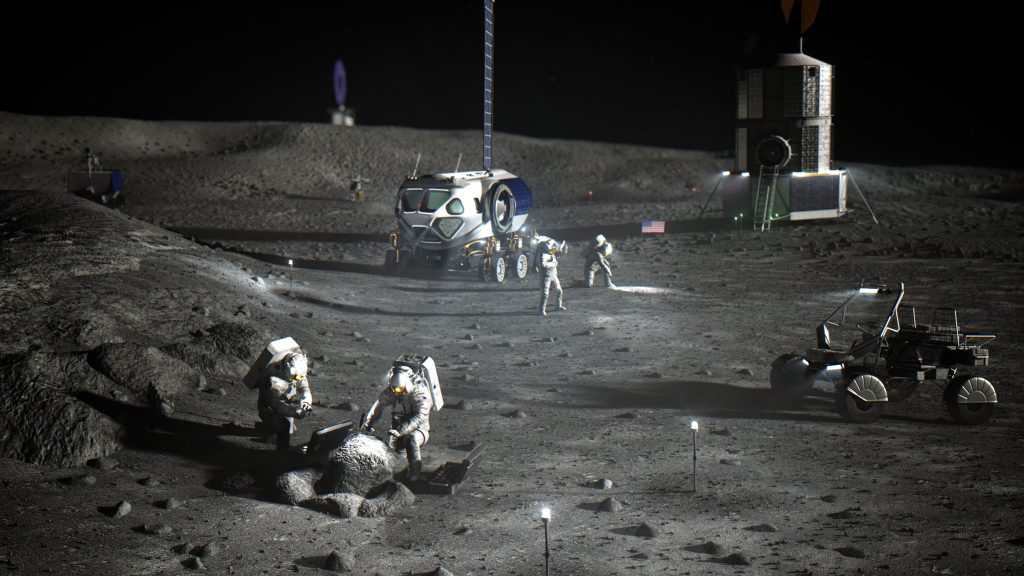Economic Opportunity Created Through Sustained Lunar Habitation by 2040

The concept of lunar habitation holds profound implications for scientific exploration, resource utilization, and the expansion of human civilization beyond Earth. This month NewSpace Global has been focused on creating an overview of the economic opportunities, essential technologies, challenges, and a timeline for the development of lunar habitation by 2040 and beyond. Given recent successful, and unsuccessful, lunar missions we thought it would be timely to provide a financially focused market overview of, and roadmap to, sustained lunar habitation.
The full report can be found at: https://lunarhabitationreport.com/
The report seeks to highlight opportunities for investors in this emerging sector of the NewSpace economy while also educating readers about emerging opportunities, technologies, and challenges of lunar exploration. While there is sustained optimism about the emerging lunar market, NSG analysts see many technical and economic challenges that could make sustained lunar habitation a more long-term investment.
Lunar resources are a potential goldmine, offering economic promise at various time horizons. These resources include water ice for propellant and life support (near term), solar power (medium term), rare minerals and metals (long term), and helium-3 for nuclear fusion (longer term). The growing market demand for lunar-derived resources necessitates an economic analysis, balancing production costs against return on investment. Key factors influencing this analysis include advancements in the energy sector, space-based manufacturing, Earth’s resource constraints, and potential international investments.
Several countries and groups, including the U.S., China, the European Union, UAE, Saudi Arabia, Japan, India, and others, have the potential for substantial investments in lunar habitation. This influx of capital not only drives economic growth but also creates jobs and fosters new industries related to scientific and technological exploration, lunar infrastructure management, space tourism, and commercial activities.
The development of lunar habitation relies on advancements in technology across several domains. Key areas include launch and transportation technologies, requiring advanced propulsion systems, reusability, and cost reduction. Transitioning to the use of lunar-developed fuel through In-Situ Resource Utilization (ISRU) is critical. Habitat and life support systems, including radiation shielding, closed-loop life support, and the use of lunar-derived resources like water and oxygen, are essential for the safety and sustainability of lunar habitation. Medical and crew support, resource extraction and utilization technologies, energy generation and storage systems, and communication infrastructure are also vital components of lunar habitation.
Challenges in lunar habitation encompass launch vehicle capabilities, human factors, health challenges, psychological well-being, environmental sustainability, international collaboration, governance, legal frameworks, ownership of lunar resources, and cultural and economic dynamics. Overcoming these challenges is critical to ensuring the success and longevity of lunar habitation projects. Additionally the economics of a lunar-based economy suggest that profitability might be a much longer-term goal than many leading industry voices believe. Using NASA’s recent OSIRIS-REx mission as a model, a potential mining operation on the moon would need to return nearly 200 kilograms of rare earth minerals a year to break even.
The development of lunar habitats will occur in several phases, including precursor missions and robotic exploration, early habitat establishment and resource assessment (with efforts at the lunar South Pole), and scaling up infrastructure and resource utilization. By 2040, we anticipate achieving self-sustaining lunar bases in multiple locations, establishing basic command and control over lunar surface and orbit, contributing to Earth’s economy through resource exports, and advancing technologies beyond lunar colonies.
The economic opportunity created through sustained lunar habitation by 2040 is immense. Leveraging lunar resources, international collaboration, and technological innovation will be pivotal in realizing the economic, scientific, and societal benefits of lunar exploration. This roadmap serves as a guide for stakeholders and decision-makers to navigate the path to a sustainable lunar future.
Learn more by downloading our new report: https://lunarhabitationreport.com/








